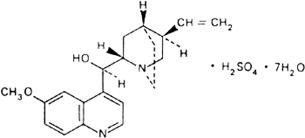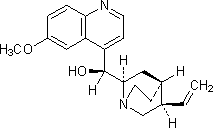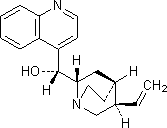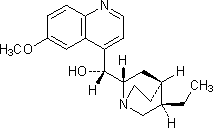Monographs: Pharmaceutical substances: Quinine bisulfate (Quinini bisulfas)
Molecular formula. C20H24N2O2,H2SO4,7H2O
Relative molecular mass. 548.6
Graphic formula.

Chemical name. Quinine sulfate (1:1) (salt), heptahydrate; (8αS,9R)-6'-methoxycinchonan-9-ol sulfate (1:1) (salt), heptahydrate; (8S,9R)-9-hydroxy-6'-methoxycinchonan sulfate (1:1) (salt), heptahydrate; CAS Reg. No. 6183-68-2 (heptahydrate).
Description. Colourless crystals or a white, crystalline powder; odourless.
Solubility. Freely soluble in water; sparingly soluble in ethanol (~750 g/l) TS.
Category. Antimalarial drug.
Storage. Quinine bisulfate should be kept in a well-closed container, protected from light.
Additional information. Quinine bisulfate effloresces in dry air. Even in the absence of light, it is gradually degraded on exposure to a humid atmosphere, the decomposition being faster at higher temperatures.
Requirements
Definition. Quinine bisulfate contains not less than 98.5% and not more than 101.5% of total alkaloids, calculated as C20H24N2O2,H2SO4 and with reference to the dried substance.
Identity tests
A. Dissolve 5 mg in 10 mL of water and add 0.05 mL of sulfuric acid (~100 g/l) TS; a strong blue fluorescence is produced (keep the solution for test B).
B. To the solution prepared for test A add 0.15 mL of bromine TS1 and 1.0 mL of ammonia (~100 g/l) TS; an emerald-green colour is produced.
C. Dissolve 0.05 g in 5 mL of water and add 1 mL of silver nitrate (40 g/l) TS; no white precipitate is produced.
D. A 20 mg/mL solution yields reaction A described under 2.1 General identification tests as characteristic of sulfates.
Specific optical rotation (1.4). Use a 30 mg/mL solution in hydrochloric acid (0.1 mol/l) VS and calculate with reference to the dried substance;  = -208° to -216°.
= -208° to -216°.
Clarity and colour of solution. Dissolve 0.20 g in 10 mL of hydrochloric acid (0.1 mol/L) VS; the solution is clear and not more intensely coloured than standard colour solution Yw2 when compared as described under 1.11.1 Colour of liquids.
Sulfated ash (2.3). Not more than 1.0 mg/g.
Loss on drying. Dry at 60°C under reduced pressure (not exceeding 0.6 kPa or about 5 mm of mercury) for 18 hours; it loses not less than 190 mg/g and not more than 240 mg/g.
pH value (1.13). pH of a 10 mg/mL solution, 2.8-3.4.
Related cinchona alkaloids.
Carry out the test as described under 1.14.1 Chromatography, High-performance liquid chromatography, using a stainless steel column (15 cm x 4.6 mm) packed with particles of silica gel, the surface of which has been modified with chemically bonded octadecylsilyl groups (5 µm).
As the mobile phase, use a solution prepared as follows. Dissolve 6.8 g of potassium dihydrogen phosphate R and 3.0 g of hexylamine R in 900 mL of water R, adjust to pH 3.0 with phosphoric acid (~1440 g/l) TS and dilute to 1000 mL with water R. Mix 920 mL of this solution with 80 mL of acetonitrile R.
Prepare the following solutions in the solvent consisting of 80 volumes of water R, 20 volumes of acetonitrile R and 0.1 volume of phosphoric acid (~1440 g/l) TS. For solution (1) dissolve a quantity of the test substance to obtain a concentration of about 3 mg per mL. For solution (2) dissolve about 30 mg of quinine sulfate RS in 10 mL of the solvent. For solution (3) dissolve about 15 mg of quinidine sulfate RS in 5 mL of solution (2).
Operate with a flow rate of 1.3 mL per minute. As a detector use an ultraviolet spectrophotometer set at a wavelength of about 316 nm.
Inject separately 10 μl each of solution (1), (2) and (3) in the chromatographic system and record the chromatograms for 2.5 times the retention time of the quinine (principal) peak in solution (2).
In the chromatogram obtained with solution (3), the following peaks are eluted at the following relative retention with reference to quinine (retention time about 10 minutes): quinidine about 0.8; dihydroquinidine about 1.2; dihydroquinine about 1.5. The test is not valid unless the resolution between the peaks due to quinidine and quinine and that between the peaks due to quinine and dihydroquinidine is at least 1.5. The chromatograms obtained with solutions (1), (2) and (3) may also show a peak due to cinchonidine eluting at a relative retention of about 0.6 with reference to quinine.
Calculate the percentage content of the related substances in the chromatogram obtained with solution (1) by normalisation. The content of dihydroquinine is not more than 10%, the content of cinchonidine not more then 5% and the content of any other related substance not more than 2.5%. The sum of the related substances is not more than 15%. Disregard any related substance of content less than 0.1%.
Assay. Dissolve about 0.45 g, accurately weighed, in 15 mL of water. Add 25 mL of sodium hydroxide (0.1 mol/l) VS and extract with 3 quantities, each of 25 mL of chloroform R. Wash the combined chloroform extracts with 20 mL of water. Dry the chloroform extracts with anhydrous sodium sulfate R, evaporate to dryness under reduced pressure, and dissolve the residue in 50 mL of glacial acetic acid R1. Titrate with perchloric acid (0.1 mol/l) VS as described under 2.6 Non-aqueous titration, Method A. Each mL of perchloric acid (0.1 mol/l) VS is equivalent to 21.13 mg of C20H24N2O2,H2SO4.
Impurities

A. (S)-[(2S,4S,5R)-5-ethenyl-1-azabicyclo[2.2.2]oct-2-yl](6-methoxyquinolin-4-yl)methanol (quinidine),

B. (R)-[(2S,4S,5R)-5-ethenyl-1-azabicyclo[2.2.2]oct-2-yl](quinolin-4-yl)methanol (cinchonidine),

C. (R)-[(2S,4S,5R)-5-ethyl-1-azabicyclo[2.2.2]oct-2-yl](6-methoxyquinolin-4-yl)methanol (dihydroquinine).